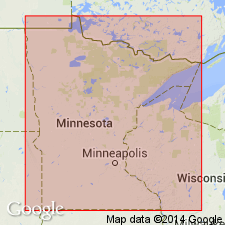
- Usage in publication:
-
- Blue Earth siltstone bed
- Modifications:
-
- Original reference
- Dominant lithology:
-
- Siltstone
- AAPG geologic province:
-
- Sioux uplift
Summary:
Blue Earth siltstone. From Ottawa to Mankato, along Minnesota River, the Kasota sandstone seems to be everywhere overlain by a thin bed of white to greenish (sometimes red) laminated argillaceous siltstone, the Blue Earth siltstone, which seems to spread beyond limits of underlying Kasota sandstone and to then rest, apparently conformably, on Jordan sandstone. The siltstone underlies Oneota dolomite, or fills irregular solution cavities along more or less vertical joints in Oneota dolomite. There is sharp break in sedimentation between Blue Earth siltstone bed and Oneota dolomite. Relations of Blue Earth siltstone bed to overlying and underlying formations are unknown. Because of historical significance of term "Blue Earth," this siltstone is here called Blue Earth siltstone bed. It occurs for some distance up Blue Earth River. Thickness at Kasota and Ottawa a few inches (Stauffer found 6 inches at Kasota); Winchell found 3 feet of the siltstone along Blue Earth River near Mankota; it probably is never much thicker. Assigned to Ordovician.
Source: US geologic names lexicon (USGS Bull. 896, p. 218-219).
For more information, please contact Nancy Stamm, Geologic Names Committee Secretary.
Asterisk (*) indicates published by U.S. Geological Survey authors.
"No current usage" (†) implies that a name has been abandoned or has fallen into disuse. Former usage and, if known, replacement name given in parentheses ( ).
Slash (/) indicates name conflicts with nomenclatural guidelines (CSN, 1933; ACSN, 1961, 1970; NACSN, 1983, 2005, 2021). May be explained within brackets ([ ]).

